
Arthur Floyd Gottfredson was an American cartoonist best known for his defining work on the Mickey Mouse comic strip, which he worked on from 1930 until his retirement in 1975. His contribution to Mickey Mouse comics is comparable to Carl Barks's on the Donald Duck comics. 17 years after his death, his memory was honored with the Disney Legends award in 2003 and induction into the Comic Book Hall of Fame in 2006.
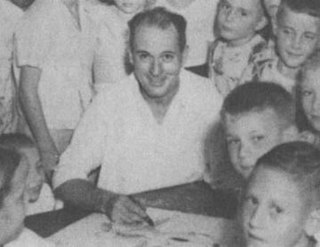
Charles Alfred "Al" Taliaferro, was an American Disney comics artist who produced Disney comic strips for King Features Syndicate. Taliaferro is best known for his work on the Donald Duck comic strip. Many of his strips were written by Bob Karp.
Uncle Scrooge Adventures is a 1987–1997 Disney comic book series published by Gladstone Publishing under license from the Walt Disney Company. It features the adventures of Scrooge McDuck and his nephews Donald, Huey, Dewey, and Louie. It was usually distinguished from the main Uncle Scrooge title in its focus on longer, full-length stories, often in the pulp adventure style.

Uncle Scrooge is a Disney comic book series starring Scrooge McDuck, his nephew Donald Duck, and grandnephews Huey, Dewey, and Louie, and revolving around their adventures in Duckburg and around the world. It was first published in Four Color Comics #386, as a spin-off of the popular Donald Duck series and is still presently ongoing. It has been produced under the aegis of several different publishers, including Western Publishing, Gladstone Publishing, Disney Comics, Gemstone Publishing, Boom! Studios, and IDW Publishing, and has undergone several hiatuses of varying length. Despite this, it has maintained the same numbering scheme throughout its six decade history, with only IDW adding a secondary numbering that started at #1.
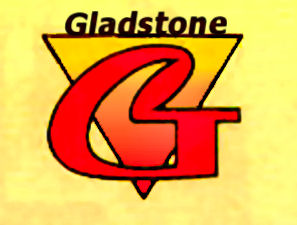
Gladstone Publishing was an American company that published Disney comics from 1986 to 1990 and from 1993 to 1998. The company had its origins as a subsidiary of Another Rainbow Publishing, a company formed by Bruce Hamilton and Russ Cochran to publish the Carl Barks Library and produce limited edition lithographs of Carl Barks oil paintings of the Disney ducks. The name references Gladstone Gander.
Disney Comics is currently a label of Disney Publishing Worldwide and was a comic book publishing company operated by The Walt Disney Company from 1990 to 1993. It was connected with W. D. Publications, Inc., which was a subsidiary of The Walt Disney Company that published Disney comics during that time span. W. D. Publications, Inc. created Disney Comics in 1990 so that The Walt Disney Company would not have to rely on outside publishers such as Gladstone Publishing. In the US, Disney only licensed Disney comic books to other publishers prior to 1990.
Disney comics are comic books and comic strips featuring characters created by the Walt Disney Company, including Mickey Mouse, Donald Duck and Uncle Scrooge.
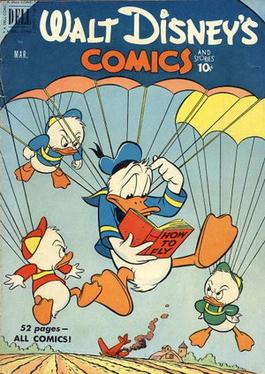
Walt Disney's Comics and Stories, sometimes abbreviated WDC&S, is an American anthology comic book series featuring characters from The Walt Disney Company's films and shorts, including Donald Duck, Scrooge McDuck, Mickey Mouse, Chip 'n Dale, Li'l Bad Wolf, Scamp, Bucky Bug, Grandma Duck, Brer Rabbit, Winnie the Pooh, and others. With more than 700 issues, Walt Disney's Comics & Stories is the longest-running Disney comic book in the United States, making it the flagship title, and is one of the best-selling comic books of all time.

Gemstone Publishing is an American company that publishes comic book price guides. The company was formed by Diamond Comic Distributors President and Chief Executive Officer Steve Geppi in 1994 when he bought Overstreet.
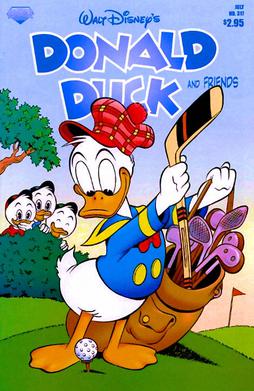
Donald Duck, also known as Donald Duck and Friends, is an American Disney comic book series starring the character Donald Duck and published by various publishers from October 1942 to June 2017. As with many early Disney comics titles, Donald Duck began as individual issues of Dell Comics' Four Color one-shots series. It was published as its own regular series in November 1952, starting with issue #26.
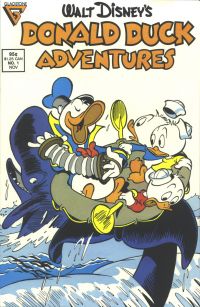
Donald Duck Adventures is a 1987–1998 Disney comic book series featuring the adventures of Donald Duck and his nephews Huey, Dewey and Louie.

Mickey Mouse Adventures was a Disney comic book first published by Disney Comics from 1990 to 1991. It featured Mickey Mouse as the main character along with other characters from the Mickey Mouse universe. Somewhat similar in style to the animated series DuckTales, it was based on the continuity of earlier print material starring Mickey, mainly Floyd Gottfredson's stories in the Mickey Mouse comic strip.
Disney's Comics in 3-D was a two-part comic book series published by Disney Comics in 1992.
Donald Duck, a cartoon character created by the Walt Disney Company, is today the star of dozens of comic-book and comic-strip stories published each month around the world. In many European countries, Donald is considered the lead character in Disney comics, more important and beloved than Mickey Mouse.

Kalle Anka & C:o is a Swedish weekly Disney comics magazine, published by Egmont. The 52-page comic, launched in September 1948, is the overall best-selling Swedish comic magazine. In the early years, the comic printed translated stories from the United States, including Walt Disney's Comics and Stories, Four Color and other Dell Comics Disney titles. As Disney comics production waned in the United States in the 1960s, Kalle Anka began printing more European-produced content, from Scandinavia and Italy. Now, Kalle Anka & C:o and its Scandinavian sister editions Anders And & Co. (Denmark) and Donald Duck & Co (Norway) are identical, apart from the language.
Topolino is an Italian digest-sized comic series featuring Disney comics. The series has had a long running history, first appearing in 1932 as a comics magazine. It is currently published by Panini Comics.
David Gerstein is an American comics author and editor as well as an animation historian. Gerstein has five books and countless comic book credits to his name. He has written many Disney comics stories, usually featuring Mickey Mouse and/or Donald Duck and provided American English script doctoring for Mickey and Donald stories that were originally written in a different language. Past employments include Egmont Creative A/S, a Danish comics studio, and Gemstone Publishing. His current work is with various affiliates of Egmont, and Fantagraphics Books.
Timeless Tales was a 2016–18 hardcover book collection series, compiling the complete runs of several Disney comics titles from IDW Publishing, including Donald Duck, Mickey Mouse, Uncle Scrooge and Walt Disney's Comics and Stories. The series were released as compiled collector's editions of the single issues of the run of each comic book title, while also in conjunction with the same issues being released in trade paperback collections. The first series to launch was Uncle Scrooge: Timeless Tales - Vol 1 in May 2016. After a total of ten hardcover volumes the four lines of the Timeless Tales series were cancelled, ending with the Walt Disney's Comics and Stories Vault - Vol. 1 in mid 2018.
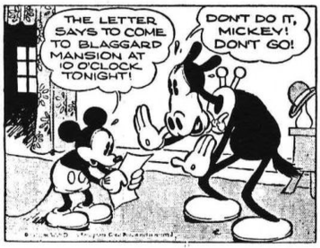
Mickey Mouse is an American newspaper comic strip by the Walt Disney Company featuring Mickey Mouse, and is the first published example of Disney comics. The strip debuted on January 13, 1930, and ran until July 29, 1995. It was syndicated by King Features Syndicate.
Uncle Remus and His Tales of Br'er Rabbit is an American Disney comic strip that ran on Sundays from October 14, 1945, to December 31, 1972. It first appeared as a topper strip for the Mickey Mouse Sunday page, but after the first few years, almost always appeared on its own. The strip replaced the 1932-1945 Silly Symphony strip, which had spent its final year on gag strips featuring Panchito from The Three Caballeros.











